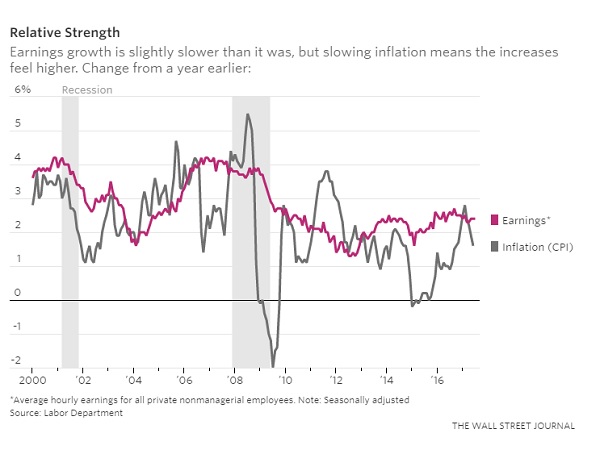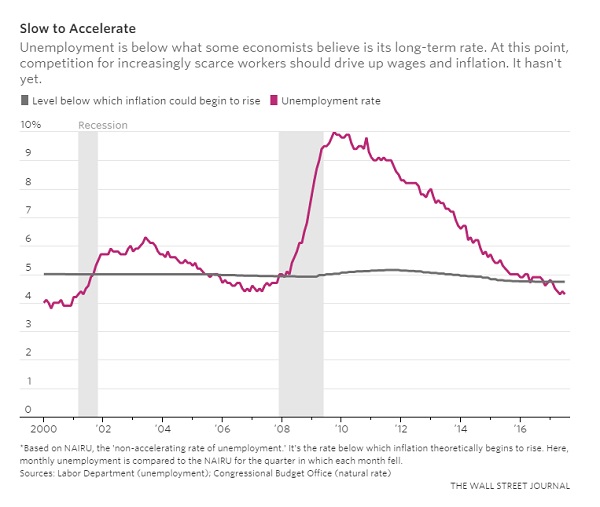U.S. employers hired
at a healthy pace in July and the unemployment rate fell to match a
16-year-low, a show of lasting vitality for the labor market.
Nonfarm
payrolls rose by a seasonally
adjusted 209,000 in July from the prior month, the Labor
Department said Friday. The unemployment rate ticked down to 4.3% from 4.4% as
more people joined the workforce. The July unemployment rate matched May’s
reading as the lowest mark since 2001.
Economists surveyed
by The Wall Street Journal had expected 180,000 new jobs and a 4.3%
unemployment rate last month.
“This employment
report provides reassurance that the real economy remained solid at the start
of the third quarter,” said Michael Pearce, economist at Capital Economics. “If
the labor market continues to tighten over the coming months…the Fed will press
ahead with rate hikes.”
June’s payroll
increase was raised to 231,000 and May’s gain down to 145,000. Hiring has
accelerated this summer, though the pace for the year remains similar to 2016’s
monthly average.
When taken together
with record stock prices, steady economic growth, low inflation and high
consumer confidence, the economy appears to be in a bit of a sweet spot.
One missing
ingredient remains wage growth. From a year earlier, hourly earnings increased
2.5% for the fourth straight month. From a month earlier, there was a 9 cent
increase, the largest gain since October, but still relatively modest.
One factor in July
could be the mix of jobs added. One in four net new jobs last month came in
restaurants, among the lowest-paying fields, that could weigh on average gains.
Health care and manufacturing jobs also grew last month.
But the wage picture
isn’t all bad. When adjusting for inflation, wages are growing at stronger rate
than their 30-year average.
Several factors
likely held back better wage growth in recent years, including weak worker
productivity gains that challenge employers to justify raises. Many economists
expect wage growth to pick up, if hiring remains steady and the unemployment
rate falls.

“I think we’re
getting to the point in many places…where they’re saying, ‘It’s going to cost
me too much money not to hire the extra labor. It’s worth paying those higher
wages’,” Eric Rosengren, president of the Federal Reserve Bank of Boston, said in an interview this week.
He said the
unemployment only recently fell below a level that should spark stronger wage
gains, which he expects are coming.
In response to broad
improvements across the labor market, the Federal Reserve has raised short-term
interest rates three times since December. Officials have penciled in one more
increase for this year and appear likely to gradually reduce the Fed’s $4.5
trillion asset portfolio, moves that could lead long-term rates to rise.
The U.S. labor
market has been a bright spot in a long recovery marked by slow growth. Economic
growth has been stuck near a 2% annual rate—the weakest expansion since World
War II. But hiring has been consistent, with payrolls expanding for 82 straight
months.

The period of
monthly gains that began in 2010 is almost 3 years longer than the second-best
streak from 1986 to 1990.
There are still some
underlying signs of softness in the labor market.
The labor-force
participation rate edged up to 62.9% in July from 62.8% the prior month, but
remains near the lowest share of adults working or seeking work since the
1970s.
Labor-force
participation has been trending lower for nearly two decades, partly because
the population is aging and more workers are retiring. It has mostly stabilized
in the past year, suggesting some Americans who had given up searching are
being drawn back to the workforce. If that is happening, the labor market might
not be as tight as the unemployment rate suggests.
An alternative
measure of unemployment and underemployment, which includes those who have
stopped looking and those in part-time jobs who want full-time positions, was
8.6% in July, unchanged from the prior month. The rate, known as the U-6, fell
as low as 7.9% in the prior economic expansion that ended in late 2007.
Click here for the original
article from Wall Street Journal.